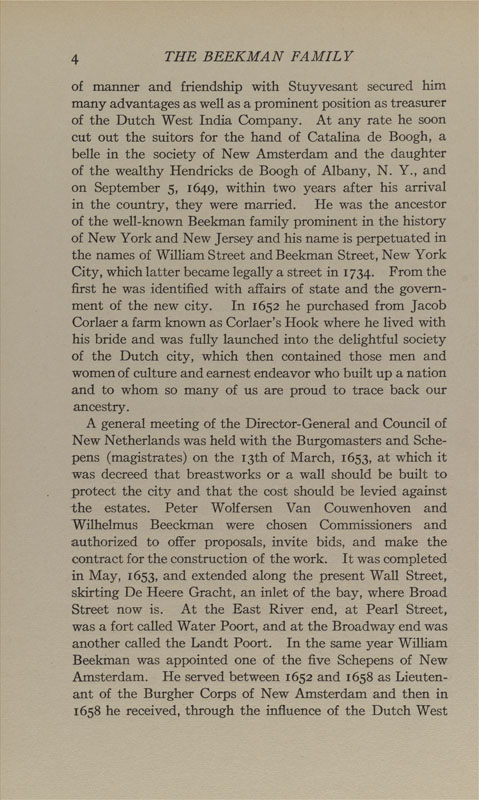4 THE BEEKMAN FAMILY
of manner and friendship with Stuyvesant secured him
many advantages as well as a prominent position as treasurer
of the Dutch West India Company. At any rate he soon
cut out the suitors for the hand of Catalina de Boogh, a
belle in the society of New Amsterdam and the daughter
of the wealthy Hendricks de Boogh of Albany, N. Y., and
on September 5, 1649, within two years after his arrival
in the country, they were married. He was the ancestor
of the well-known Beekman family prominent in the history
of New York and New Jersey and his name is perpetuated in
the names of William Street and Beekman Street, New York
City, which latter became legally a street in 1734. From the
first he was identified with affairs of state and the govern¬
ment of the new city. In 1652 he purchased from Jacob
Corlaer a farm known as Corlaer's Hook where he lived with
his bride and was fully launched into the delightful society
of the Dutch city, which then contained those men and
women of culture and earnest endeavor who built up a nation
and to whom so many of us are proud to trace back our
ancestry.
A general meeting of the Director-General and Coimcil of
New Netherlands was held with the Burgomasters and Sche-
pens (magistrates) on the 13th of March, 1653, at which it
was decreed that breastworks or a wall should be built to
protect the city and that the cost should be levied against
the estates. Peter Wolfersen Van Couwenhoven and
Wilhelmus Beeckman were chosen Commissioners and
authorized to offer proposals, invite bids, and make the
contract for the construction of the work. It was completed
in May, 1653, and extended along the present Wall Street,
skirting De Heere Gracht, an inlet of the bay, where Broad
Street now is. At the East River end, at Pearl Street,
was a fort called Water Poort, and at the Broadway end was
another called the Landt Poort. In the same year William
Beekman was appointed one of the five Schepens of New
Amsterdam. He served between 1652 and 1658 as Lieuten¬
ant of the Burgher Corps of New Amsterdam and then in
1658 he received, through the influence of the Dutch West
|








